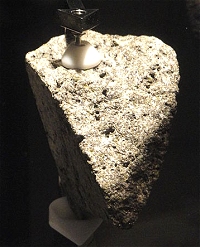
November Editorial
Magnetic Moon Rocks

November Editorial
Magnetic Moon Rocks
|
For the last 50 years or so scientists have puzzled over the Moon’s magnetic rocks. Unlike the Earth, the Moon does not have a magnetic field. No magnetism equals no magnetic rocks - yes? Well, no, as proven by moon rocks brought to the earth during the Apollo missions in 1960s and 1970s. These rocks show some degree of magnetism, but how and why the magnetism developed has been a mystery.
|
The Earth’s magnetic field is relatively easily explained. It is generated by a process known as a ‘geodynamo’. The geodynamo is thought to be a ‘convective’ dynamo‘ within the outer fluid core which surrounds the Earth’s solid inner core. Both the outer and the inner cores of our planet are largely iron. The solid inner core is large (approximately the size of the Moon) and very hot. At the boundary between the inner core and and outer core there is a degree of movement of fluid generated partly by the material and partly by temperature. As the fluid rises and twists it shears across the existing magnetic field and generates a new one. | |
|
However, the Moon is too small to generate the same ‘geodynamo’ effects and tests have shown that the Moon does not generate any magnetic field. So why do moon rocks show otherwise? This question might finally have been answered. A group for scientists at the University of California Santa Cruz and the California Institute of Technology have provided a plausible model which explains the mystery. In a recent Nature paper (see reference below) the scientists argue from the fact that the Moon was much closer to the Earth when both bodies were newly formed. Consequently, as the Moon circled the Earth the gravitational forces involved were powerful enough to set the satellite's small liquid core into motion. To use the words of Professor Nimmo, the group’s spokesman: ‘The moon wobbles a bit as it spins - that's called precession - but the core is liquid, and it doesn't do exactly the same precession. So the mantle is moving back and forth across the core, and that stirs up the core’. The authors have provided evidence that this type of physical motion, which started some 4.2 billion years ago (the Earth is about 4.5 billion years old) would indeed be sufficient to create a magnetic field on the Moon. But the Moon has been moving steadily away from the Earth ever since. At a certain point the Earth’s gravitational forces became too weak to sustain the dynamo on the ever-receding Moon. The scientists estimated that the dynamo shut down around 2.7 billion years ago and thereafter the Moon’s magnetic field slowly diminished and eventually vanished altogether. Although the Moon ceased to produce a magnetic field, the moon rocks retained the magnetism. This gives us a window into the Moon’s early history, a window which has ramifications for other objects in the solar system. As C.A. Dwyer, the leading author of the Nature article, says: ‘A working model of a lunar dynamo, combined with more detailed paleomagnetic analysis of moon rocks, could give scientists a powerful tool for investigating the history of the Moon. This mechanism may also be applicable to dynamos in other bodies, such as large asteroids’. Journal Reference: C. A. Dwyer, D. J. Stevenson, F. Nimmo. A long-lived lunar dynamo driven by continuous mechanical stirring. Nature, 2011; 479 pp: 212. | |
| _______________________________ | ||||
| Home | | | Shopping | | | Database |
© Biscuit Software 2004-2015
All rights reserved